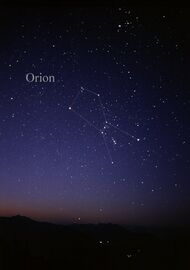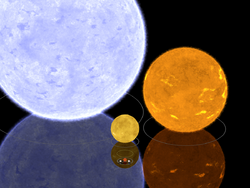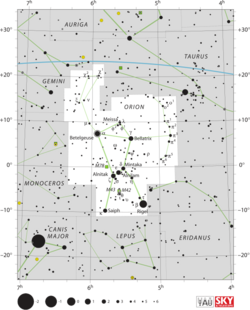Astronomy:Bellatrix
| Observation data Equinox J2000.0]] (ICRS) | |
|---|---|
| Constellation | Orion |
| Pronunciation | /ˈbɛlətrɪks/ /bɛˈleɪtrɪks/[1] |
| Right ascension | 05h 25m 07.86325s[2] |
| Declination | +06° 20′ 58.9318″[2] |
| Apparent magnitude (V) | 1.64[3] (1.59 - 1.64[4]) |
| Characteristics | |
| Spectral type | B2 III[5] or B2V[6] |
| U−B color index | −0.86[3] |
| B−V color index | −0.21[3] |
| Variable type | Suspected[4] |
| Astrometry | |
| Radial velocity (Rv) | +18.2[7] km/s |
| Proper motion (μ) | RA: −8.11[2] mas/yr Dec.: −12.88[2] mas/yr |
| Parallax (π) | 12.92 ± 0.52[2] mas |
| Distance | 250 ± 10 ly (77 ± 3 pc) |
| Absolute magnitude (MV) | −2.78[8] |
| Details | |
| Mass | 7.7[9] M☉ |
| Radius | 5.75[9] R☉ |
| Luminosity | 9,211[9] L☉ |
| Surface gravity (log g) | 3.60[10] cgs |
| Temperature | 21,800[9] K |
| Metallicity [Fe/H] | −0.07[9] dex |
| Rotational velocity (v sin i) | 52[11] km/s |
| Age | 25.2[12] Myr |
| Other designations | |
| Database references | |
| SIMBAD | data |
Bellatrix is the third-brightest star in the constellation of Orion, positioned 5° west of the red supergiant Betelgeuse (Alpha Orionis). It has the Bayer designation γ Orionis, which is Latinized to Gamma Orionis. With a slightly variable magnitude of around 1.6, it is typically the 25th-brightest star in the night sky. Located at a distance of 250±10 light-years from the Sun, it is a blue giant star around 7.7 times as massive as the sun with 5.75 times its diameter.
Nomenclature

The traditional name Bellatrix is from the Latin bellātrix "female warrior"; it first appeared in the works of Abu Ma'shar al-Balkhi and Johannes Hispalensis, where it originally referred to Capella, but was transferred to Gamma Orionis by the Vienna school of astronomers in the 15th century, and appeared in contemporary reprints of the Alfonsine tables.[15] In 2016, the International Astronomical Union organized a Working Group on Star Names (WGSN)[16] to catalog and standardize proper names for stars. The WGSN's first bulletin of July 2016[17] included a table of the first two batches of names approved by the WGSN; which included Bellatrix for this star. It is now so entered in the IAU Catalog of Star Names.[18] The designation of Bellatrix as γ Orionis (Latinized to Gamma Orionis) was made by Johann Bayer in 1603. The "gamma" designation is commonly given to the third-brightest star in each constellation.
Standard star
Bellatrix has been used as both a photometric and spectral standard star, but both characteristics have been shown to be unreliable.
In 1963, Bellatrix was included with a set of bright stars used to define the UBV magnitude system. These are used for comparison with other stars to check for variability, and so by definition, the apparent magnitude of Bellatrix was set to 1.64.[19] However, when an all-sky photometry survey was carried out in 1988, this star was suspected to be variable. It was measured ranging in apparent magnitude from 1.59 to 1.64,[20] and appears to be a low amplitude, possibly irregular variable.[21]
Physical properties

The spectral types for O and early B stars were defined more rigorously in 1971 and Bellatrix was used as a standard for the B2 III type.[22] The expected brightness of Bellatrix from this spectral type is about one magnitude brighter than calculated from its apparent magnitude and Hipparcos distance.[23] Analysis of the observed characteristics of the star indicate that it should be a B2 main sequence star, not the giant that it appears from its spectral type.[6] Close analysis of high resolution spectra suggest that it is a spectroscopic binary composed of two similar stars less luminous than a B2 giant.[24]
Bellatrix is a massive star with about 7.7 times the mass and 5.8 times the radius of the Sun.[9] It has an estimated age of approximately 25 million years[12]—old enough for a star of this mass to consume the hydrogen at its core and begin to evolve away from the main sequence into a giant star.[25] The effective temperature of the outer envelope of this star is 22,000 K,[10] which is considerably hotter than the 5,778 K on the Sun. This high temperature gives this star the blue-white hue that occurs with B-type stars.[26] It shows a projected rotational velocity of around 52 km/s.[11] Bellatrix may have sufficient mass to end its life in a supernova explosion.[25]
Companions
Bellatrix was thought to belong to the Orion OB1 association of stars that share a common motion through space, along with the stars of Orion's Belt: Alnitak (Zeta Orionis), Alnilam (Epsilon Orionis), and Mintaka (Delta Orionis). However, this is no longer believed to be the case, as Bellatrix is now known to be much closer than the rest of the group.[25] It is not known to have a stellar companion,[27] although researchers Maria-Fernanda Nieva and Norbert Przybilla raised the possibility it might be a spectroscopic binary.[24] A 2011 search for nearby companions failed to conclusively find any objects that share a proper motion with Bellatrix. Three nearby candidates were all found to be background stars.[28]
Some researchers suspected that Bellatrix was a member of 32 Orionis group. The 32 Ori group should be termed the Bellatrix Cluster on the basis that the sky position and distance of Bellatrix are similar to those of the 32 Ori group.[29] The proper motion of Bellatrix deviates significantly from the mean motion of the group, leaving its membership in question. However, it may be possible to reconcile membership if the divergent velocity is the result of an unseen companion. For example, a face-on orbit with a black hole companion orbiting ~100 astronomical unit|AU from the star with a period measured in centuries could account for the discrepancy.[30]
Etymology and cultural significance
Bellatrix was also called the Amazon Star, which Richard Hinckley Allen proposed came from a loose translation of the Arabic name Al Najīd, the Conqueror.[13] A c.1275 Arabic celestial globe records the name as المرزم "the lion".[31] Bellatrix is one of the four navigational stars in Orion that are used for celestial navigation.[32]
In the 17th century catalogue of stars in the Calendarium of Al Achsasi al Mouakket, this star was designated Menkib al Jauza al Aisr, which was translated into Latin as Humerus Sinister Gigantis (The Left Shoulder of the Giant).[33]
The Wardaman people of northern Australia know Bellatrix as Banjan, the sparkling pigment used in ceremonies conducted by Rigel the Red Kangaroo Leader in a songline when Orion is high in the sky. The other stars of Orion are his ceremonial tools and entourage. Betelgeuse is Ya-jungin "Owl Eyes Flicking", watching the ceremonies.[34]
To the Inuit, the appearance of Betelgeuse and Bellatrix high in the southern sky after sunset marked the beginning of spring and lengthening days in late February and early March. The two stars were known as Akuttujuuk "those (two) placed far apart", referring to the distance between them, mainly to people from North Baffin Island and Melville Peninsula.[35]
See also
References
- ↑ Kunitzsch, Paul; Smart, Tim (2006). A Dictionary of Modern star Names: A Short Guide to 254 Star Names and Their Derivations (2nd rev. ed.). Cambridge, Massachusetts: Sky Pub. ISBN 978-1-931559-44-7.
- ↑ 2.0 2.1 2.2 2.3 2.4 van Leeuwen, F. (November 2007). "Validation of the new Hipparcos reduction". Astronomy and Astrophysics 474 (2): 653–664. doi:10.1051/0004-6361:20078357. Bibcode: 2007A&A...474..653V.
- ↑ 3.0 3.1 3.2 Crawford, D. L.; Barnes, J. V.; Golson, J. C. (December 1971). "Four-color, Hbeta, and UBV photometry for bright B-type stars in the northern hemisphere". Astronomical Journal 76: 1058–1071. doi:10.1086/111220. Bibcode: 1971AJ.....76.1058C.
- ↑ 4.0 4.1 Samus, N. N. et al. (2009). "VizieR Online Data Catalog: General Catalogue of Variable Stars (Samus+ 2007-2013)". VizieR On-line Data Catalog: B/GCVS. Originally Published in: 2009yCat....102025S 1. Bibcode: 2009yCat....102025S.
- ↑ Morgan, W. W.; Keenan, P. C. (1973). "Spectral Classification". Annual Review of Astronomy and Astrophysics 11: 29. doi:10.1146/annurev.aa.11.090173.000333. Bibcode: 1973ARA&A..11...29M.
- ↑ 6.0 6.1 Levenhagen, R. S.; Leister, N. V. (2006). "Spectroscopic analysis of southern B and Be stars". Monthly Notices of the Royal Astronomical Society 371 (1): 252–262. doi:10.1111/j.1365-2966.2006.10655.x. Bibcode: 2006MNRAS.371..252L.
- ↑ Wilson, R. E. (1953). "General Catalogue of Stellar Radial Velocities". Washington (Carnegie Institute of Washington, D.C.). Bibcode: 1953GCRV..C......0W.
- ↑ Lamers, H. J. G. L. M.; Harzevoort, J. M. A. G.; Schrijver, H.; Hoogerwerf, R.; Kudritzki, R. P. (1997). "The effect of rotation on the absolute visual magnitudes of OB stars measured with Hipparcos". Astronomy and Astrophysics 325: L25. Bibcode: 1997A&A...325L..25L.
- ↑ 9.0 9.1 9.2 9.3 9.4 9.5 Challouf, M.; Nardetto, N.; Mourard, D.; Graczyk, D.; Aroui, H.; Chesneau, O.; Delaa, O.; Pietrzyński, G. et al. (2014). "Improving the surface brightness-color relation for early-type stars using optical interferometry⋆". Astronomy & Astrophysics 570: A104. doi:10.1051/0004-6361/201423772. Bibcode: 2014A&A...570A.104C.
- ↑ 10.0 10.1 Lefever, K. et al. (June 2010). "Spectroscopic determination of the fundamental parameters of 66 B-type stars in the field-of-view of the CoRoT satellite". Astronomy and Astrophysics 515: A74. doi:10.1051/0004-6361/200911956. Bibcode: 2010A&A...515A..74L.
- ↑ 11.0 11.1 Simón-Díaz, S.; Herrero, A. (2014). "The IACOB project. I. Rotational velocities in northern Galactic O- and early B-type stars revisited. The impact of other sources of line-broadening". Astronomy & Astrophysics 562: A135. doi:10.1051/0004-6361/201322758. Bibcode: 2014A&A...562A.135S.
- ↑ 12.0 12.1 Tetzlaff, N.; Neuhäuser, R.; Hohle, M. M. (2011). "A catalogue of young runaway Hipparcos stars within 3 kpc from the Sun". Monthly Notices of the Royal Astronomical Society 410 (1): 190–200. doi:10.1111/j.1365-2966.2010.17434.x. Bibcode: 2011MNRAS.410..190T.
- ↑ 13.0 13.1 13.2 Allen, Richard H. (1963). Star Names: Their Lore and Meaning (reprint ed.). New York City , NY: Dover Publications Inc.. p. 237. ISBN 0-486-21079-0. https://archive.org/details/bub_gb_5xQuAAAAIAAJ.
- ↑ "BELLATRIX -- Variable Star". SIMBAD (Centre de Données astronomiques de Strasbourg). http://simbad.u-strasbg.fr/simbad/sim-id?Ident=Gamma+Orionis.
- ↑ Kunitzsch, Paul (1986). "The Star Catalogue Commonly Appended to the Alfonsine Tables". Journal for the History of Astronomy 17 (49): 89–98. doi:10.1177/002182868601700202. Bibcode: 1986JHA....17...89K.
- ↑ "IAU Working Group on Star Names (WGSN)". https://www.iau.org/science/scientific_bodies/working_groups/280/.
- ↑ "Bulletin of the IAU Working Group on Star Names, No. 1". http://www.pas.rochester.edu/~emamajek/WGSN/WGSN_bulletin1.pdf.
- ↑ "IAU Catalog of Star Names". http://www.pas.rochester.edu/~emamajek/WGSN/IAU-CSN.txt.
- ↑ Johnson, H. L. (1963). "Photometric Systems". Basic Astronomical Data: Stars and Stellar Systems: 204. Bibcode: 1963bad..book..204J.
- ↑ Krisciunas, K. (May 1994). "Further Photometry of alpha Ori and gamma Ori". Information Bulletin on Variable Stars 4028: 1. Bibcode: 1994IBVS.4028....1K.
- ↑ Krisciunas, K. (May 1994). "Further Photometry of alpha Ori and gamma Ori". Information Bulletin on Variable Stars 4028: 1. Bibcode: 1994IBVS.4028....1K.
- ↑ Walborn, Nolan R. (1971). "Some Spectroscopic Characteristics of the OB Stars: An Investigation of the Space Distribution of Certain OB Stars and the Reference Frame of the Classification". Astrophysical Journal Supplement 23: 257. doi:10.1086/190239. Bibcode: 1971ApJS...23..257W.
- ↑ Schröder, S. E.; Kaper, L.; Lamers, H. J. G. L. M.; Brown, A. G. A. (2004). "On the Hipparcos parallaxes of O stars". Astronomy and Astrophysics 428: 149–157. doi:10.1051/0004-6361:20047185. Bibcode: 2004A&A...428..149S.
- ↑ 24.0 24.1 Nieva, Maria-Fernanda; Przybilla, Norbert (2012). "Present-day cosmic abundances. A comprehensive study of nearby early B-type stars and implications for stellar and Galactic evolution and interstellar dust models". Astronomy & Astrophysics 539A: 143–63. doi:10.1051/0004-6361/201118158. Bibcode: 2012A&A...539A.143N.
- ↑ 25.0 25.1 25.2 Kaler, James B.. "BELLATRIX (Gamma Orionis)". Stars. University of Illinois. http://stars.astro.illinois.edu/sow/bellatrix.html.
- ↑ "The Colour of Stars". Australia Telescope, Outreach and Education. Commonwealth Scientific and Industrial Research Organisation. December 21, 2004. http://outreach.atnf.csiro.au/education/senior/astrophysics/photometry_colour.html.
- ↑ Eggleton, P. P.; Tokovinin, A. A. (September 2008). "A catalogue of multiplicity among bright stellar systems". Monthly Notices of the Royal Astronomical Society 389 (2): 869–879. doi:10.1111/j.1365-2966.2008.13596.x. Bibcode: 2008MNRAS.389..869E.
- ↑ Janson, Markus et al. (August 2011). "High-contrast Imaging Search for Planets and Brown Dwarfs around the Most Massive Stars in the Solar Neighborhood". The Astrophysical Journal 736 (2): 89. doi:10.1088/0004-637X/736/2/89. Bibcode: 2011ApJ...736...89J.
- ↑ Bouy, H.; Alves, J. (December 2015). "Cosmography of OB stars in the solar neighbourhood". Astronomy & Astrophysics 584: A26. doi:10.1051/0004-6361/201527058. ISSN 0004-6361. Bibcode: 2015A&A...584A..26B.
- ↑ Bell, Cameron P. M. et al. (June 2017). "A stellar census of the nearby, young 32 Orionis group". Monthly Notices of the Royal Astronomical Society 468 (1): 1198–1220. doi:10.1093/mnras/stx535. Bibcode: 2017MNRAS.468.1198B.
- ↑ Dorn, Bernhard (July 1830). "Description of the Celestial Globe belonging to Major-General Sir John Malcolm, G.C.B., K.L.S., &c. &c., deposited in the Museum of the Royal Asiatic Society of Great Britain and Ireland". Transactions of the Royal Asiatic Society of Great Britain and Ireland 2 (2): 371–392. doi:10.1017/S0950473700000513. https://zenodo.org/record/1807366.
- ↑ Bennett, George G. (2011). Complete On-Board Celestial Navigation 2011-2015. DoctorZed Publishing. p. 172. ISBN 978-0-9870924-0-3. https://books.google.com/books?id=cLHeY3bbLbMC&pg=PA172.
- ↑ Knobel, E. B. (June 1895). "Al Achsasi Al Mouakket, on a catalogue of stars in the Calendarium of Mohammad Al Achsasi Al Mouakket". Monthly Notices of the Royal Astronomical Society 55 (8): 429. doi:10.1093/mnras/55.8.429. Bibcode: 1895MNRAS..55..429K.
- ↑ Harney, Bill Yidumduma; Cairns, Hugh C. (2004). Dark Sparklers (Revised ed.). Merimbula, New South Wales: Hugh C. Cairns. pp. 139–40. ISBN 0-9750908-0-1.
- ↑ MacDonald, John (1998). The Arctic sky: Inuit astronomy, star lore, and legend. Toronto, Ontario/Iqaluit, NWT: Royal Ontario Museum/Nunavut Research Institute. pp. 52–54, 119. ISBN 9780888544278. https://archive.org/details/arcticskyinuitas0000macd/page/52.
External links
- Spectrum of Bellatrix
- Navigational Stars
Coordinates: ![]() 05h 25m 07.9s, +06° 20′ 59″
05h 25m 07.9s, +06° 20′ 59″
 |


